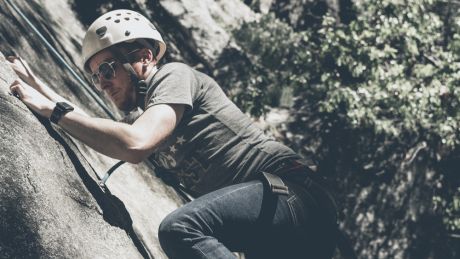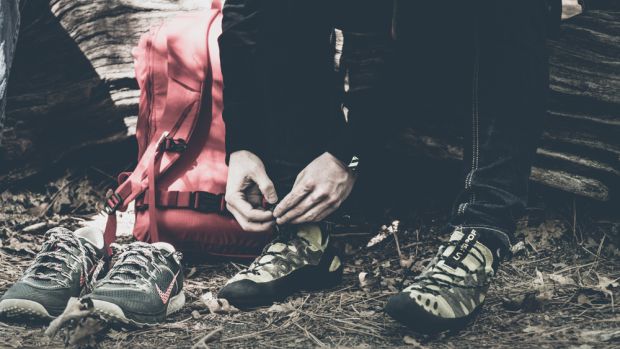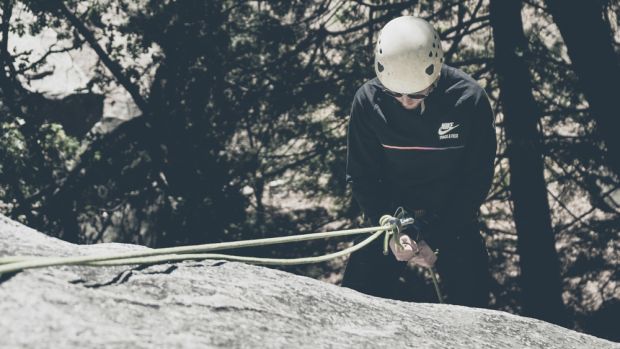Rock Climbing in Yosemite
If there is a capital of rock climbing, it’s Yosemite in California. Coach’s Ben Isaacs donned the harness and attempted an ascent

Learning to climb in Yosemite National Park is a bit like choosing to do your first 5km race at the Olympic Stadium or trying your first round of golf at the Augusta National. It’s inspiring, but it’s also a lot of pressure. Rock climbing as we know it came of age at Yosemite, and in North America climbs are rated by difficulty on the Yosemite Decimal System. But you can’t let the fact it’s beloved by experts make you think it’s no place for beginners.
Swan Slab is an ideal starting point for newcomers – at 60ft in height at its lowest point it will still make you feel like a hero when you complete an ascent. As with all new activities, there’s plenty to learn. Depending on what time of year you go, for example, mosquitoes could be out in force, so make sure you’re well sprayed with suitable repellent. If one of the little b*stards starts draining your blood mid-climb there’s not really a lot you can do about it.
Lesson two is that it’s hard to write about climbing. Not because it’s difficult to convey the experience, but because your fingertips can be so frayed and tender from a day of doing it that using a keyboard is a painful endeavour. As a beginner, you don’t spend much time pulling yourself up by your fingers, but they’ll come into contact with enough rough rock to make you feel like you’ve worn a layer away. Experienced climbers develop tougher skin, but the average pampered office worker will find it a rather chastening experience initially.
To make any progress up a mountain you’ll need some ill-fitting climbing shoes. The odd-looking, smooth-soled, tight-fitting footwear (“They should feel comfortably snug”, I was told as I tried them on, “without pinching”) is the most essential piece of kit you’ll wear. Although you should never attempt to climb without a helmet, at least it’s possible to do so, but without these shoes you won’t make it up to the first toehold.

RECOMMENDED: The Best Places to Go Rock Climbing in London
Before you begin a climb you need to wipe the soles on your trousers to clear off the grit and dust that will prevent your shoes from sticking to the wall. As tight as mine were I actually wish I’d got them even tighter because it helps you stick in the toeholds.
Contrary to what you might guess, your leg muscles will be the workhorses when you start climbing. Any visions you had of it being an extreme pull-ups session will be obliterated when you discover how important it is to “step up”. Once you have a climbing shoe pushed in a toehold with your knee bent, you then have to push hard through your thighs to straighten up enough to find the next spot. Solid quad strength will be a bonus here, but calves can get tired quite quickly. I’d been suffering off and on with Achilles pain from hill running back in the UK, and also uphill hiking in Yosemite the day before (12 miles and the equivalent of 210 flights of stairs), so this came back with a vengeance when I was standing in toeholds looking for the next step, because of the way your toes can point up and stretch out your Achilles. So don’t stop for too long if you can help it.
Get the Coach Newsletter
Sign up for workout ideas, training advice, reviews of the latest gear and more.
I’m not scared of heights but I have a pretty healthy fear of putting myself in a position where I could realistically fall to my doom from a great distance. This was most pressing at the very beginning when we had to abseil (or “rapel” as the Americans call it) down a rock for the first time. Although I knew it was safe – someone had already done it and I was firmly attached to the anchor – persuading my feet to step off, and for my upper body to lean back, took more work than I expected. It feels totally counter-intuitive – and bonkers – but once the first step was taken and I could feel myself supported by the harness I was able to relax and even enjoy it. It’s not very physically taxing and yet makes you feel like a proper climber – a huge confidence boost before starting an ascent.

RECOMMENDED: Where to Start Rock Climbing Outdoors
I was about half way into my first climb when I got “the fear”. I’m not sure exactly what brought it on, but it crept up from my ever-important toes through my once-powerful legs, shot up my spine, made my fingertips feel weak and settled in my head. My mouth was so dry it was as if I’d been up all night doing shots of soy sauce. I felt like I had the eyes of the world on me rather than a handful of other beginners. Maybe it was just the fatigue; it’s hard to relax doing this as a newbie, but it’s also impossible to keep your body tense and not suffer ill-effects. Until this point my only fear had been not being able to do it at all or cracking the face of my Apple watch on the rock. Now every finger or toehold seemed too small or too far away. It became a psychological battle. Rock climbing isn’t just you versus the wall, it’s your body versus your mind. To combat this, I just reminded myself that I’d got 30ft up just fine and that I was well secured – there was no reason to think I couldn’t do another 30ft or that I’d even fall anywhere if I lost my footing. With my head cleared I was able to put the fear out my mind and continue the ascent.
It’s almost impossible to measure how many calories you’ll burn from climbing because unlike, say a run or swim, ascents vary dramatically and will always involve some periods of standing round. But a sure sign of a good calorie burn from an activity is an intense appetite in the hours that follow – you’ll polish off a big dinner, that’s for sure. If you’re having lunch out on the mountain keep it relatively light – you don’t want to feel weighed down. A good option is to buy an “unmade” packed lunch. The constituent elements are all individually wrapped in cling-film so when you assemble it on the mountain your sandwich will be fresh rather than soggy. You’ll usually get a side of trail mix with it as well – grazing on dried fruit and nuts in between climbs is vital for maintaining energy.
If you’re a total newbie you probably wouldn’t devote two consecutive days to the activity, but in case you’re considering it – don’t. I was told I might have difficulty getting dressed the following morning, a suggestion I laughed off because I either run or go to the gym four or five days a week back home. Laughs gave way to groans when I attempted to shower the next morning. Due to constant droughts it’s bad manners to take long showers in California. I did wonder if the water shortages were due to the difficulty people have washing after this sort of activity.
Thanks to Patagonia and GoPro for providing some essential climbing gear.
Ben Isaacs was the features editor of the print edition of Coach until it shuttered in 2016. Ben is currently the features editor at The Week Junior.

